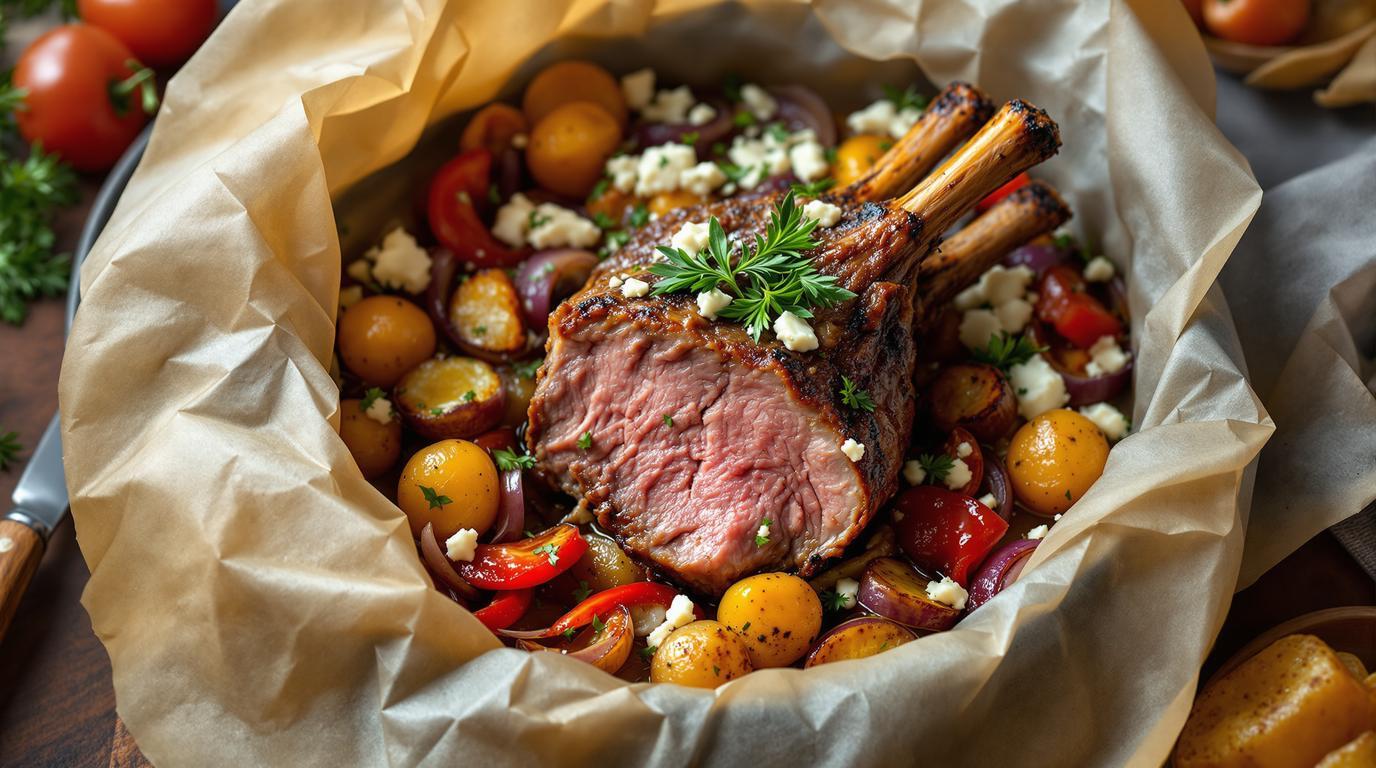There’s something truly magical about Greek kleftiko that transports me back to my first visit to a small taverna in Crete. The restaurant owner proudly explained how this dish dates back to the 1800s when Greek freedom fighters called “klephts” would cook stolen lambs in sealed underground pits to prevent smoke from giving away their location. I was captivated by this ingenious cooking method that has evolved into one of the most tender, aromatic lamb dishes in Mediterranean cuisine. Today, I’m sharing my perfected version that honors those traditional techniques while being completely achievable in your home kitchen. 🇬🇷
The Soul of Greek Kleftiko
At its heart, kleftiko is a celebration of patience. The magic happens when lamb slowly cooks in its own juices, creating an incredibly tender texture that practically melts in your mouth. While traditional methods involved underground pits, we’ll recreate that sealed environment using parchment paper – a technique that delivers remarkably authentic results.
The beauty of kleftiko lies in its simplicity. Lamb, potatoes, and Mediterranean aromatics develop complex flavors during the long, slow roast. Each ingredient contributes essential elements: lamb provides richness, potatoes absorb the savory juices, and the herbs create that unmistakable Greek aroma profile. 🌿
Essential Ingredients
- 3½–4 pounds (1.5–2 kg) bone-in lamb shoulder (preferred) or leg
- 3 pounds (1.3 kg) Yukon Gold potatoes, cut into 2-inch chunks
- 10 garlic cloves, left whole
- 1 large red onion, cut into wedges
- 2 bell peppers (red and green), roughly chopped
- 2 ripe tomatoes, quartered
- ½ cup (120ml) extra virgin olive oil
- ½ cup (120ml) dry white wine
- Juice of 1 large lemon
- 2 tablespoons dried oregano
- 1 tablespoon fresh thyme leaves (or 1 teaspoon dried)
- 1 teaspoon dried rosemary
- 4 ounces (115g) feta cheese (optional)
- Sea salt and freshly ground black pepper
The Authentic Method
- Prepare the lamb: Make small incisions throughout the meat and insert half the garlic cloves. In a bowl, combine 4 tablespoons olive oil, lemon juice, oregano, thyme, rosemary, salt, and pepper. Rub this mixture all over the lamb. Cover and marinate refrigerated for at least 2 hours, preferably overnight. 🧄
- Prep the vegetables: Toss potatoes, peppers, tomatoes, onion, and remaining garlic with 2 tablespoons olive oil and a generous pinch of the herbs. Season with salt and pepper.
- Assemble the parcel: Preheat oven to 300°F (150°C). Lay two large, overlapping sheets of parchment paper in a deep roasting pan, creating a cross. Place half the vegetables on the bottom, position the lamb on top, then arrange remaining vegetables around it. Pour over the wine and remaining olive oil.
- Seal tightly: Fold the parchment paper over to completely enclose the contents, crimping and folding edges to create a tight seal. This mimics the traditional sealed cooking environment that traps all flavors and moisture. 📦
- Slow-roast: Bake for 3½-4 hours until the lamb is fork-tender and falling off the bone. For a crispier finish, open the parchment for the final 15 minutes of cooking.
Chef’s Note: The shoulder cut is my preferred choice for kleftiko. While many recipes call for leg of lamb, the shoulder contains more connective tissue that breaks down during slow cooking, resulting in a more succulent, flavorful dish. If using leg, reduce cooking time by about 30 minutes.
Serving Traditions
For an authentic Greek dining experience, bring the entire parchment package to the table and open it dramatically in front of your guests. The escaping steam carries an irresistible aroma that builds anticipation! Serve with a simple Greek salad and crusty bread to soak up the incredible juices. A crisp Assyrtiko wine from Santorini makes the perfect pairing. 🍷
If you’re looking for other Mediterranean inspirations, my one-pot jambalaya brings similar slow-cooked comfort with a Cajun twist.
This dish reminds me that sometimes the most profound cooking techniques come from necessity. Those Greek rebels couldn’t have imagined their clever cooking method would evolve into one of the world’s most beloved lamb preparations. The next time you’re looking for something truly special, remember that like my grandmother’s ice water trick for pie crust or traditional Swedish princess cake, sometimes the old ways truly are best. Perhaps like Scottish grandma’s porridge, the simplest methods yield the most extraordinary results. Enjoy this journey to Greece through your kitchen! 🇬🇷
